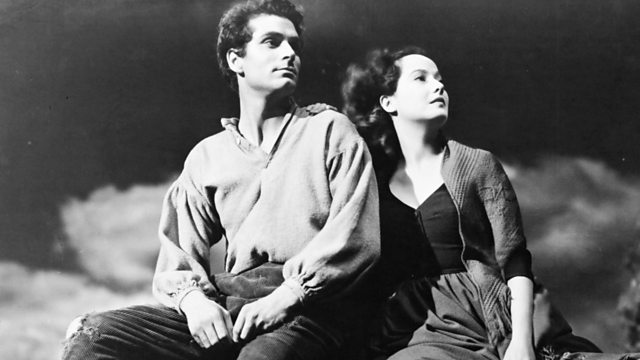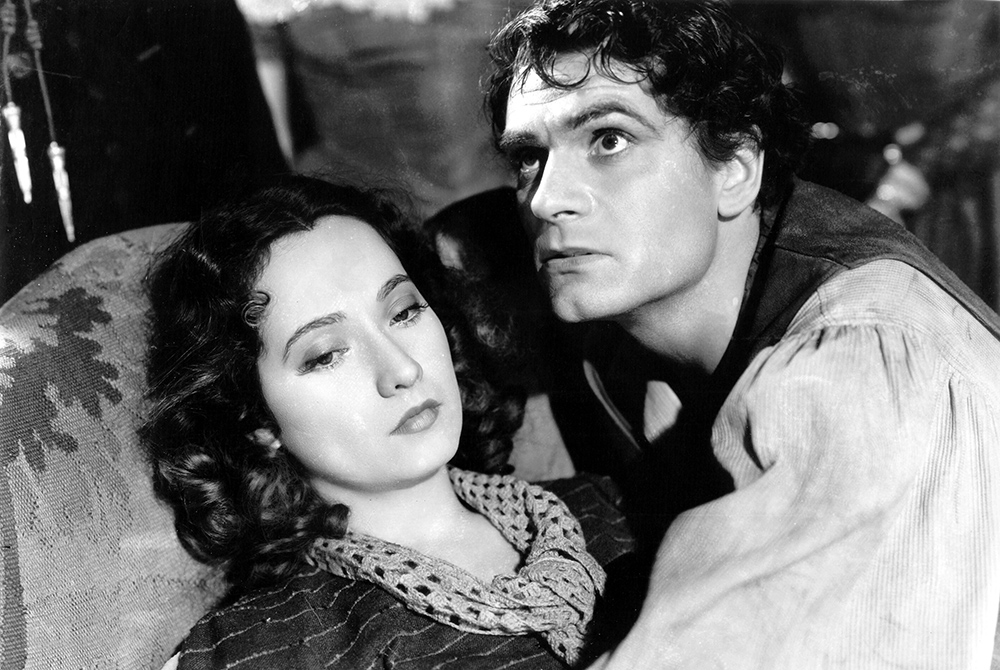Emily Brontë’s Wuthering Heights is a novel built upon the foundations of two interconnected and interdependent stories, each chiefly concerned with a different generation of the Earnshaw, Linton, and Heathcliff families; the stories effectively form two halves of the novel, and the lives and experiences of the characters therein mesh deeply in the very soul of the work. To thus disregard the second half of the novel vouchsafes the fate of Milo; to neglect the evolution of the remainder of the work is to tear Wuthering Heights from the center, to split the rocks of Penistone Crags, and to sunder Heathcliff from his Catherine and Catherine from her Heathcliff. The themes of ignorance versus education, religion versus spirituality, and revenge versus love interact and develop through the second half of the novel, cultivating Hareton’s intellect and nobility, tempering Catherine Junior’s naive mockery and disdain, and extinguishing Heathcliff’s all-consuming drive for retribution to enable a denouement of wholesome character metamorphoses and ultimately a sense of redemption over the sins of prior generations.
The simultaneous blossoming of spirituality and education precipitates fundamental change in characters and in their situations, with love as the unifying force in the novel. In Chapter 16, March 20th—the vernal equinox— marks both the death of Catherine (hereafter Cathy) and the birth of her daughter Catherine Junior (hereafter Cathy2). On a bright, cheerful morning following the tumultuous decline of Cathy, Nelly finds Heathcliff beneath an ash tree replete with new spring buds; both the tree and Heathcliff bear stigmata—the leaves of the old ash tree, which itself symbolizes rebirth, grow from a C-shaped scar referencing the spectral Cathy, and Heathcliff “dashe[s] his head against the knotted trunk,” staining his head, forehead, and the tree sanguine (158). Heathcliff’s unbearable pain drives him to exact a sadistic revenge against Edgar—and Cathy for leaving him—by torturing their children. Notwithstanding hatred and grief, the third generation still flowers. Out of Hareton’s shooting accident some 18 years following said scene comes momentous change: on Easter Monday, Cathy2 decides to resurrect their relationship from the abysmal clouds of jealous smoke. The Biblical references in this section—building off of Easter and Heathcliff’s stigmata—further the theme of spirituality and religion, as Brontë’s molding of traditional concepts mirrors what her characters do. For example, the number five—a symbol of God’s goodness and grace—is ubiquitous throughout Chapter 33. In particular, Brontë includes the Five Offerings—Burnt, Sin, Trespass, Grain, and Peace—from the Old Testament, which are an outward expression of a person’s inward desire to restore broken relationships. For example, the Trespass or Guilt Offering was set at a prescribed fiscal amount to make reparations; however, Cathy2 instead bestows upon her wronged companion “at least five kisses” (289). Furthermore, instead of offering a cow or a sheep for slaughtering, Cathy2 presents Hareton with a book wrapped in white. Thus while there is a Biblical basis for some of the acts in Chapter 33, Cathy2 is making less of an effort to appease some detached “God” as she is attempting to forge an enduring spiritual connection to Hareton; the unique variations that Cathy2 and Hareton impart represent their idea of spiritual religion as juxtaposed with Joseph’s cold, hypocritical, and hollow traditional “brick-and-mortar” religion. Building off of spirituality, education enables Hareton’s profound transformation from crooked tree to noble savage. With Cathy2’s gift, no longer are books a barrier; rather, they become the vehicle for Hareton’s emancipation from the cruel grip of ignorance, as his true nature of gold greatly outshines Linton’s worthless tin and “[shakes] off rapidly the clouds of ignorance and degradation in which it had been bred” (302). Paralleling Hareton, the Heights itself is reborn—as Hareton replaces the thorny gooseberry and currant bushes with flowers from the Grange, the Heights changes from a stale fortress of misery and revenge to a vivacious sanctuary of love and peace, with open doors, warm fires, and refreshing fragrance. With Hareton and Cathy2 “sworn allies” brought together by civilization and the Heights embodying their spiritual love, Heathcliff—after snatching the book from Hareton—hands the volume back in a symbolic acknowledgement of the triumph of spirituality and education over religion and illiteracy (296). Thus, Cathy2 and Hareton’s incipient bond can flourish from its originally acrimonious beginnings.
The ultimate victory of love over revenge is an integral part of the second half; the relationships of artifice wither while those of love flourish in order to bring a complete and peaceful resolution to the turbulent drama throughout Wuthering Heights. Since the beginning of the novel, revenge and violence have been potent forces whose latent undercurrents occasionally bubble to the fore. Lockwood’s dream about Reverend Jabez Branderham’s sermon “Seventy Times Seven, and the First of the Seventy-First” illustrates not only the hypocrisy of religion, but also the omnipresence of savagery lurking beneath a thin veneer of “Christianity,” as Lockwood and the preacher readily incite violence. In a similar vein, Heathcliff’s raw emotions manifest themselves in aggression, as exemplified by his brawl with Hindley. However, malevolence is not indefatigable; only pure relationships endure as love subsumes revenge. Hareton and Cathy2’s intimacy is in marked contrast to that of Heathcliff and Cathy with balance, rather than destructive extremity, the basis for their love; they each recognize each other’s faults, and, together, with “both their minds tending to the same point—one loving and desiring to esteem, and the other loving and desiring to be esteemed—they contrived in the end to reach it [happiness]” (297). Unlike her mother or Heathcliff, Cathy2 is an amalgamation of the finest Earnshaw and Linton qualities: she has the Earnshaw dark eyes, but also the more delicate, fair skin and hair; “Her anger was never furious: her love never fierce: it was deep and tender” (178). Contrary to Cathy who let her purity like snowmelt be tainted by the seductive wine of society, Cathy2 and Hareton resist the pull of society and “neither experienc[e] nor evinc[e] the sentiments of sober disenchanted maturity;” they remain pure, like children (303). In addition to their innocence, Cathy2 and Hareton are steadfast—they prove themselves willing to compromise. In Chapter 33, Cathy2 gives Heathcliff a vitriolic diatribe in which she asserts her—and Hareton’s—rights. However, Hareton corrects Cathy2’s indiscretionary outburst by explicating his “chains, forged by habit, which it would be cruel to attempt to loosen”—notwithstanding the monster Heathcliff is, Hareton will defend him because of love, however strange it may seem; Heathcliff, despite his temper, did catch Hareton after Hindley, in a drunken rage, threw the babe from the balcony (302). Accordingly, Cathy2 “show[s] a good heart” and never “breathe[s] a syllable…against her oppressor,” and her relationship with Hareton only grows stronger (302). Like Cathy2 and Hareton, the garden at the Heights shifts to accommodate Joseph’s complaints, which in turn enables a sense of balance and harmony; Heathcliff and Cathy’s unbridled and intense passion would have nullified any possible modus vivendi with the surrounding world, as they and they alone constitute the entirety of their universe, a cosmic dance for two alone. The second half of the novel also facilitates the completion of various cycles: Isabella and Heathcliff’s “pale, delicate, effeminate,” “whey-faced whining wretch” of a child Linton, whom Heathcliff deliberately exploits out of avarice to obtain Wuthering Heights and Thrushcross Grange, dies, along with his hollow marriage to Cathy2 (188, 197). Although Cathy did arguably love Edgar, their union was purely of earth, but the product of that relationship—Cathy2—results in the restoration of the Earnshaw family, the removal of the cuckoo from the nest, and reparations for Heathcliff’s malignant machinations. The denouement of the novel, thus, rests entirely on relationships and how they evolve in the second half.
Building off of the growth of Hareton and Cathy2’s relationship, Heathcliff’s death itself is a paramount concluding moment in the novel. As the poet Virgil so simply put it, “love conquers all”—love, not passion, resolves the novel and softens Heathcliff’s twisted, black heart. Heathcliff’s confession to Nelly of seeing Cathy’s corpse highlights his recognition—after 18 years—of the veracity of Cathy’s remark that the only way she and Heathcliff can be together is through death, and, therefore, the hope of escaping with Cathy that Heathcliff has desperately clung to like a moth to a flame was only a hollow illusion. That epiphany, in conjunction with Hareton and Cathy2’s overflowing abundance of love, brings Heathcliff to abandon his plans to revenge: “I get levers and mattocks to demolish the two houses, and train myself to be capable of working like Hercules, and when everything is ready, and in my power, I find the will to lift a slate off either roof has vanished….I have lost the faculty of enjoying their destruction, and I am too idle to destroy for nothing” (303). Having at last forgone his earthly pursuits, Heathcliff’s body begins to break. The anguish that he had concealed beneath a facade of malintent and revenge—all of his latent and repressed conflict—bursts forth rather like air from a puncture in a balloon. Heathcliff experiences a division between his inner spirituality and outer physicality—between his soul and his body; Cathy is pulling on his soul, a lost half searching for its complement. That crack in his impregnable conscience festers, as his inner conflict that had before manifested itself through violence now manifests itself through fasting, until his body simply fails as all of the air buoying it up escapes, along with his soul. Heathcliff observes, “they [his being and faculties] have yearned towards it so long, and so unwaveringly, that I’m convinced it will be reached—and soon—because it has devoured my existence”—the “one universal idea” of Cathy quite literally consumes him (305). Like an intricate clock, Heathcliff constitutes a series of highly disciplined instruments to affect his destruction. With his intense focus for revenge liquidated, his disjointed body crumbles as his soul wavers between earth and the realm beyond. Thus death is, in effect, a release for his soul from the confines of his shattered somatic prison—in Chapter 34, his body vibrates as if Cathy is his resonant frequency, their souls beating in unison. For Heathcliff, death is not a barrier but rather a bridge; indeed, as he emaciates by self-starvation, he, much to Cathy2 and Hareton’s surprise, becomes uncannily sanguine not at the propinquity of his death per se, but of his salvation. When Heathcliff does eventually die, Nelly tries and fails “to extinguish, if possible, that frightful, life-like gaze of exultation before any one else beheld it” (315). As the eyes are windows to the soul, Nelly cannot shut Heathcliff’s eyelids because she cannot extinguish his essence; she cannot suppress Heathcliff’s released spirit flapping the lattice, finally reunited with its long-lost half to roam the interminable moor sea in perpetuity. With Heathcliff gone, Hareton and Cathy2 can thrive like grouse exposed no longer to the traps and diabolical whims of the vindictive marksman, a freedom from Heathcliff aptly symbolized by their marriage on New Year’s Day.
Removing the final seventeen chapters thus bars the organic culmination and change, embodied by the triumph of love, that fundamentally resolve the conflict interwoven into the soul of Wuthering Heights. The second half orchestrates a satisfying coda—after 320 prior dissonant and passionate pages—of hindsight and foresight, of life and death; omitting that moment is to blind Janus and rob that final glimpse through Lockwood’s eyes of the genuine happiness of Hareton and Cathy2 with their households conjoined, of the transcendental fulfillment of Heathcliff and Cathy’s spiritual—and physical—union, and of the myriad harebells, each promising everlasting love and constancy, flourishing beneath the benign and quiet evening sky.

I wrote the above essay for an essay contest from Random House Books; the question I chose to answer was, “The 1939 movie adaptation of Wuthering Heights ends with the deaths of Catherine and Heathcliff, leaving out the events of the second part of the novel. Do you think the second part of the novel is necessary? If not, why not? If so, in what ways does it develop the characters and/or expand the themes of the first part?” Unfortunately, due to COVID-19, the competition will no longer be happening, but I thought I would post it nonetheless.

If you liked this analysis of Wuthering Heights, then be sure to watch me elucidate the symbol of Penistone Crags in the below YouTube video:

ananya
Hi! ❤️🧡💛💚💙💜 Great essay, very insightful!
scholinoscar
❤️❤️1437 🙂